When you get further into riding you can tweak a few things.
One of those ‘things’ is working out the gearing on your bike, you can muck around with online ratio calculators to find out what works or go ride your mates’ bikes set up.
For those that don’t know what I mean.
It is simply about making A turn B.
A. Is your legs, i.e. one full turn of your pedals (crank / chainring)
B. Is your back wheel, a full turn on your back wheel.
So a 1:1 would be one 1 full turn of your pedals (crank) = 1 full turn of your wheels.
Things come into play like wheel size, rear cassette gearing range, the front crank size and your physical ability to turn over that crank with resistance (aka a big wheel attached to it). Blah Blah. – try not to glaze over.
For the purpose of this post:
Front Crank or Crank or Crank Ring = The toothed Chainring attached to your crank arms (then your pedals go on each end)
Since it is not possible to have a 29″sized crank ring to turn your 29″sized rear wheel, you have to do the “drive” through gearing and ratios of that made through a rear cassette a chain and a front crank.
Like, if your front crank is small and your bike wheel is big. It is really about how many turns of that small crank = 1 full turn of that big bike wheel and you not suffering in the process of making that happen.
When you are going fast in high gear you want your rear wheel to turn over faster relative to the pumping of your legs to cover more ground. The harder you ride the faster you should go.
But,
when you are climbing up a big bloody hill, you sort of want the reverse of that. You want it to be easy on your legs to turn that back wheel faster to gain more distance up said very horrible hill.
This is gearing.
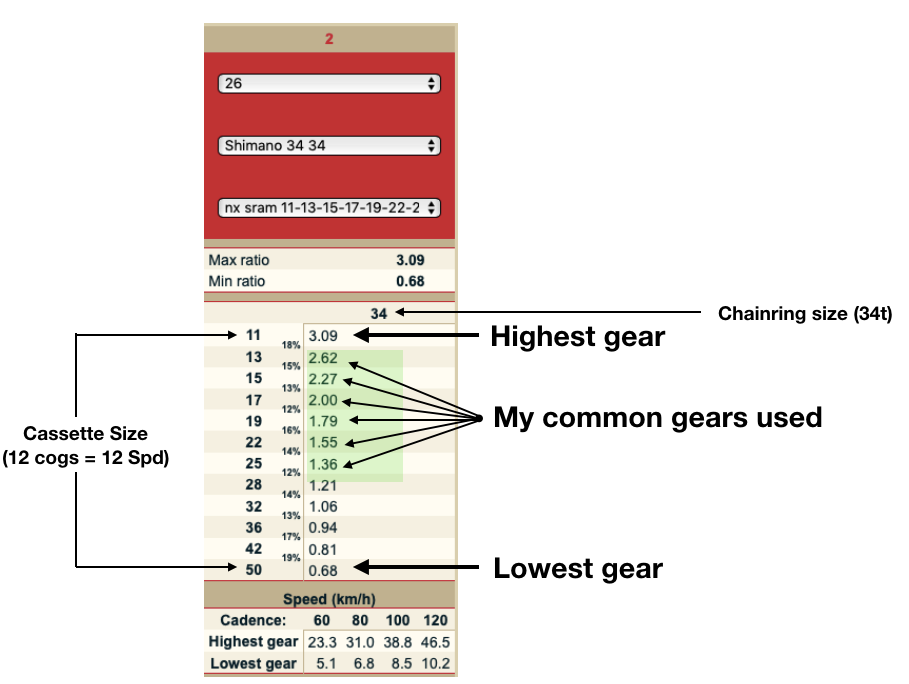
It is expressed as ratio number: i.e 3.09
So on my new 12x set up, 34 crank and 11-50 cassette a 3.09 means that one full turn of my crank = 3.09 turns of my rear wheel. In this instance that is my top gear.
A 0.68 ratio number would then mean. That one full turn of my front crank = 68% of a full turn of my back wheel. This would be a very low gear.
With a online ratio calculator you can calculate the lowest and highest speed that you can ‘pedal’ your bike at:
Mine are: Top speed in highest gear is 46.5 km/hr and lowest gear is 5.1 km/hr.
Obviously you can roll faster than this, especially if there is a downhill involved and you are chasing Jason. (who is doing 70km/hr)
Another way to look at km/hr speed is those calculated numbers are the absolute MAX and MINIMUM speeds you can get out of your bike when pedalling.
So for me to chase Jason at 70km per hour, Ive already maxed out the bikes gearing capabilities at 46.5 km/hr and the additional 23.5 km/hr is pure stupidity encouraged on being able to roll down a really steep hill. (did I mention this is also on gravel, he is that cray cray!)
So why does this matter?
In a nutshell, If when biking you feel like you just can’t get enough out of the gearing on your bike, you can change things up a bit so that you do.
For example. The Epic Evo (Jas and Phil have, I have a broken one), I always felt there was a dead spot in the 1 x 12 gearing for me. When I went to the fat boy the dead spot disappeared but the gearing range seemed similar to the Epic Evo. (not the same as it was a different crank to cassette set up)
Confused?
Let’s break it down
On the front you have a chainring, it has teeth on it. You can have 3, 2 or 1 chainring(s). (the chainring attaches to crank arms, you’re pedals attach to the end of those arms)
The chain is driven by the teeth on your front crank(s) which your legs do the initial work in turning that crank and chainring


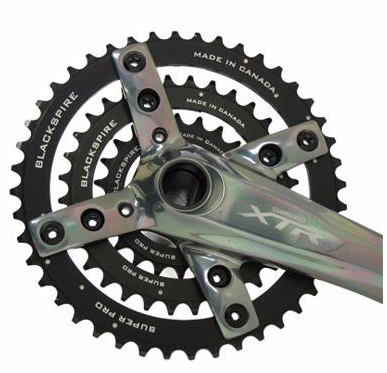
The chain connects to your rear cassette that has a range of gears, this is connected by your…’bike chain’.
For the Rear cassette, this is what they call in ‘retail’ bike speak, the Speed.

aka, 9 Speed, 10 Speed, 11 Speed and 12 Speed.
a 9 speed has 9 cogs on its rear cassette
a 12 speed has 12 cogs on its rear cassette

Speed is also shared between your combination of front cranks, a 2 x or 3 x.
Easy!
For the typical rider, you should be looking for 3 main things:
- A low gear so that you can ride up a hill
- A high gear so that you can go fast and race your mates
- A range of “commonly used” gears so you can just ride without dying. (Not in your highest or lowest gear)
So why do we need to change gearing?
- great question.
- The Answer is for better riding Efficiency.
Lets set the record straight. If you are happy with how your bike performs by the way you ride it, then stay in that lane. No need to change.
However, if you want more efficiency when riding which also means better bike performance and control. Getting the right gear sorted can make a huge difference to your biking ability.
So what does efficiency mean in term of MTB biking?
If your setup is right for you, you should be able to move comfortably through your gears up and down maintaining a constant pace while doing so.
This is great for example, when you are riding a track and there is a slight uphill you can drop the gearing down but keep your pace. This is efficency.
Same goes for changing up. Too much of a Jump up will slow you down. Your legs need to be able to quickly adjust to the additional load on them, while maintaining the current pace.
Ideally you are looking for:
- Not bog down on each gear change (because the gear you went to was too hard compared to the last)
- or to spin way to fast (because it jumped down too much of a lower gear). Suddenly spinning fast when it’s not really warranted is a waste of energy, plus you look stupid.
(If this is the problem you are experiencing with your gear changes then your current set up is not right for your type of riding)
So when you buy a new bike, there is no way that a bike manufacturer is going to know exactly what type of rider is going to be riding it.
What you get is the best bike gearing ratios for a generalised audience.
This isn’t bad, they would have done months of research and development and testing to work this out and they do it well.
Therefore, if you need to change, you can. It just costs money.
But do it right, don’t throw money at it, do some research.
For me personally. I want to ensure that I am riding as efficiently as I can every time. I don’t like being buggered on the bike because it kills the enjoyment of riding for me. The exception for that statement is racing, when you race you are operating between 80 -100% max effort and you will get buggered. But for general rides, I just want to keep going and going.
What I do hate seeing is riders choosing the wrong gear and wasting energy then complaining about how their ride sucked. It’s really how they are riding is what sucks.
A little education in this area, especially for the young ones starting out can make a difference to their overall experience with MTBing.
Here is my final set up for the Fat Boy. We couldn’t put the GX 10-50 cassette on due to the connection to the freehub thing, so settled on an 11-50 NX cassette, paired with the GX derailleur and the Eagle 12speed grip shift shifter.
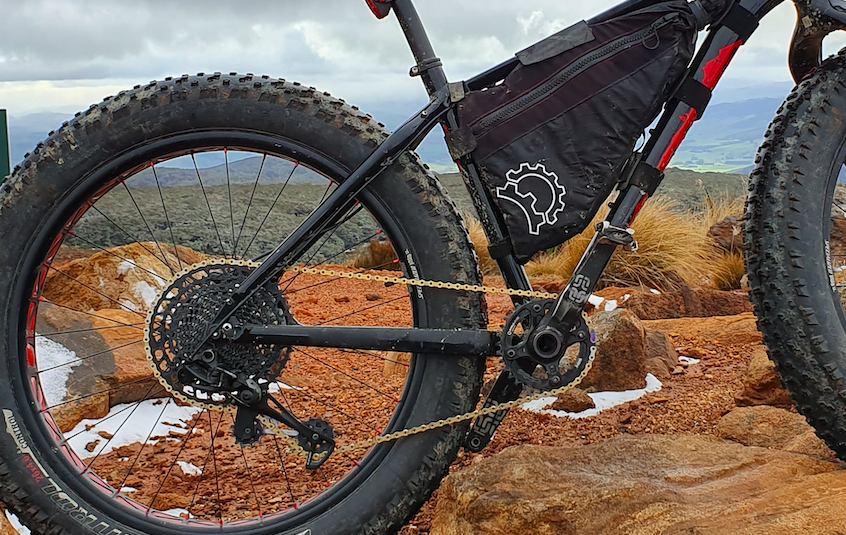
I spent a bit of time working this out.
The Fat Boys standard 2×10 system, 11-36 cassette and 22/36 crank is quite good. Old but good.
But riding the 36 crank on the Fat Boys standard 2×10 especially when you are tired did get pretty hard after a while and the 22 crank was too easy.
My objective was to get a gearing set up that did the following:
- Gave me a good workable range, so that
- I could climb well
- I had a top speed when and where needed
- I had good jumps between the gearing for general riding so that I don’t bog down on too of a higher gear shift ratio or waste energy if the change down is too much of a lower jump.
I needed gearing shifts that complimented how I rode. (important)
- Lighten the load. Losing the front derailleur saved me 250 grams.
- Work with the Grip Shift. I simply like the grip shifts over the lever shifters. Gripshift aside from being SO 1990 is very easy to use and fast to action when racing.

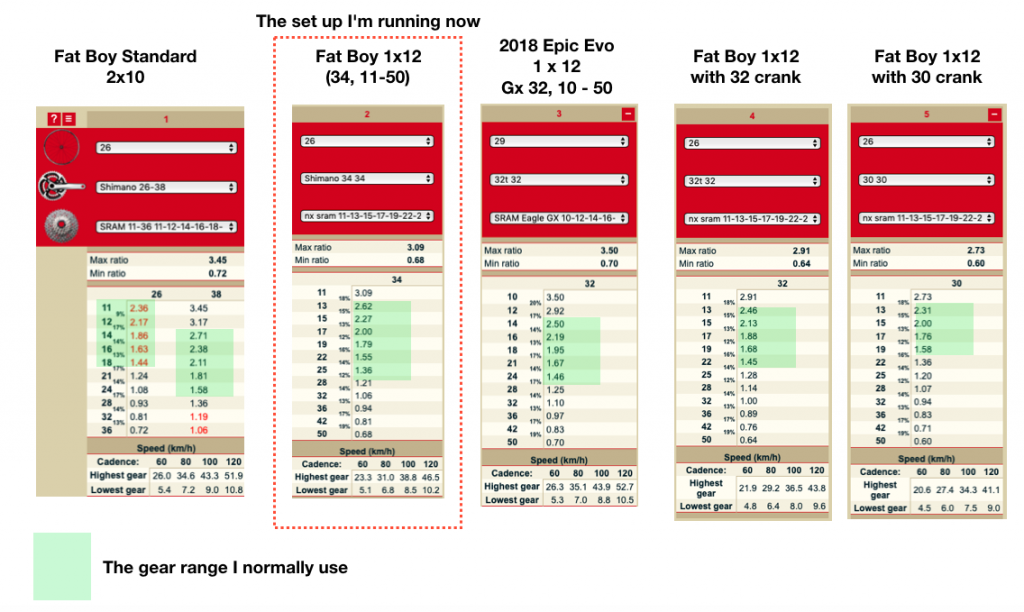
Some cool things I have noticed in comparison to my previous Epic Evo (1x12speed, 32 crank and 10 – 50 cassette)
The Fat Boy climbs exceptionally well. I didn’t notice much difference between the Epic Evo and the Fat Boys new set up.
– there is about $3K difference between these bikes. But operational wise for climbing, Same-Same.
In my commonly used gears. This set up is a good close range for me. Im not losing much time between gear shifts in being able to maintain a constant output and pace.
Top gear. I don’t often use this but when I do, I aim to always beat Jason…
What about your bike?
So the above story is about me. If some of what I said is relative to your set up, the question you should have is what can you do.
What I haven’t mention above is bike fitness. I suggest that before you start changing up your gear ratios you first ensure that it is not your fitness level that is the real cause of your biking inefficiency. Because if it is, and you go and change your gearing set up it won’t be right for you when you truely are ‘bike’ fit.
If, however you feel like your biking fitness is good and the inefficiency is in your set up. Then start with the bike ratio calculator.
http://gears.mtbcrosscountry.com
You need to know what you currently have and where in your existing gearing set up it is comfortable for you to ride.
Using that, create another instance of the ratio calc changing the crank size.
In some case just changing the front crank size can be a game changer but this is not always true for everyone.
Let’s use a mate called Tim, his new bike as an example. (Im guessing the preferred riding ratios he uses)
Tim is fit enough but his bike gear changes are not agreeing with his type of riding.
Tim is riding a 2 x 11 speed set up. Two cranks at the front 26 and 36 tooth and a 11-42 11 speed on the back.
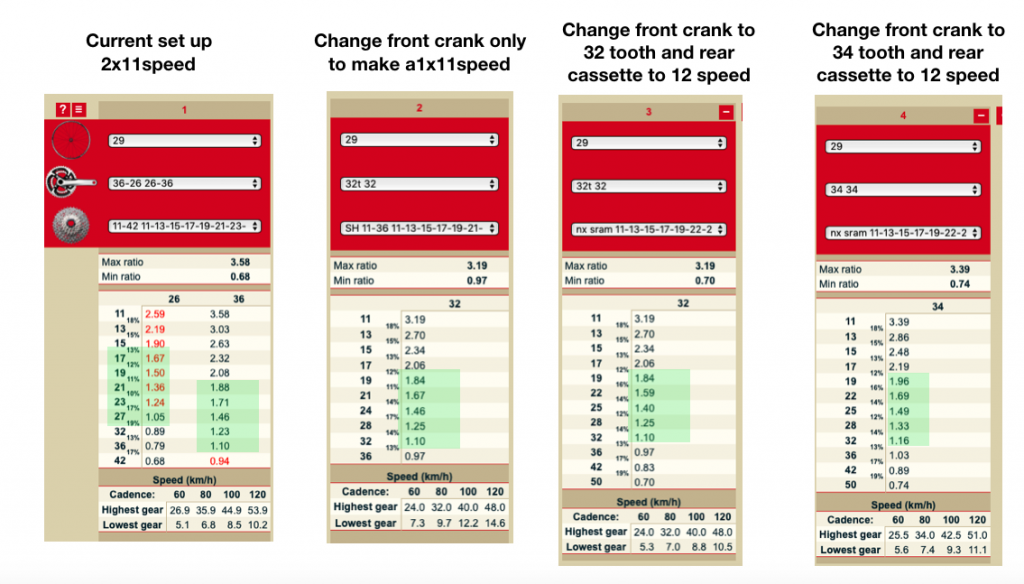
Tim finds that the gearing isn’t quite right for him just yet as a jump up is sometimes a bit too hard to push over. He also gets a bit lost when changing between the 2x front crank system.
Lets say he is talking about the jump between the ratio 1.80 to 2.0 on the 36 cog (Image 1).
As an example, I’ve put Tims riding range in the above. (Tim this is just a guess)
Image 2: If we just changed Tims crank to a 32 (1x system) keeping the rear cassette the same at the 11 speed, there wouldn’t be much advantage in doing this. His wallet will be lighter and he would look cool but there would be very little gain in his biking efficiency. Worth it?, No.
Image 3: Then if we went ahead and make it a 12 speed and kept the 32 crank, again he hasn’t gained much. What Tim really needs is something suitable between the 1.80 to 2.0 ratio.
Image 4: We achieve that by changing to a 12 speed and also to a 34 crank. Tim gets a better incremental ratio jump.
This is the sort of home work you need to do to find the ratio that works for you.
Finally you have to look at your calculated High and Low gear ratios.
When you compare the Tims Ratio Images 1 and 4 together. Tim loses some high gearing and also some low gearing in comparison to his original set up. However how often are you biking in the highest and lowest gear?.
In the high gear you may be racing your mate for say 10 – 30 seconds and in the low gear its generally Ï just need to get up this hill type of mission and you don’t care.
What is important are your everyday “commonly used’gears, this is what I’ve highlighted in green on the images and are the gears that you will likely be riding in 90% of the time.
Where do I go next?
If change is in the air for you. Firstly talk to your local bike shop. They can tell you what you can and can’t do. If you have a low end(ish) bike typically it has a 3x system, it is likely cheaper for you to go buy a new bike than you muck around chasing gearing.
If your bike is top of the low end range and or in the mid range of bikes. You likely already have a 2x or 1x system and because of that you have some easier upgrade paths to explore.

